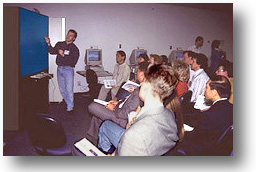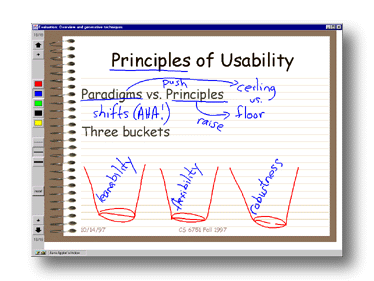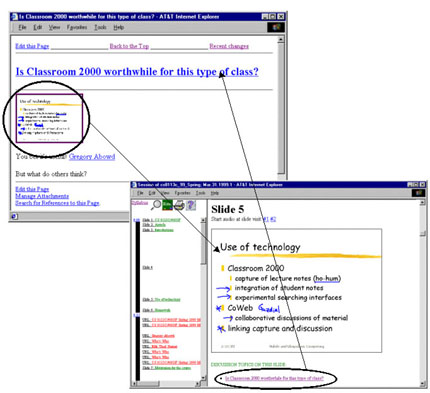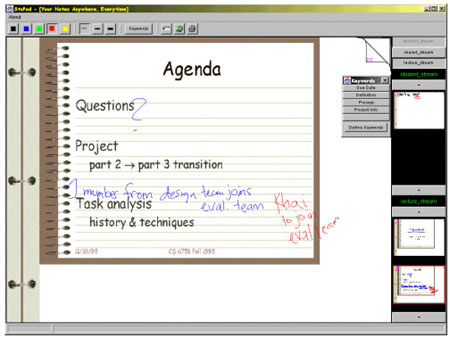Serving education through ubiquitous computing
 Overview
Overview
Classroom 2000 is an attempt to study the impact of ubiquitous computing
on education. We have built a prototype classroom environment and the
necessary software infrastructure to seamlessly capture much of the rich
interaction that occurs in a typical university lecture. By capturing
the different streams of activity in the classroom and presenting an
easily accessible interface that integrates those streams together,
we reduce the need for mundane note-taking, allowing the student to engage
in and better understand the classroom discussion. Our ultimate goal is
to revolutionize the classroom experience through the evolutionary
introduction of a natural and useful capture, integration and access service.
 Capturing the lecture experience
Capturing the lecture experience
We empower professors by providing software tools for use with
electronic whiteboards. Professors can fully use our tools with minimal
effort and change to their current routine. Whiteboard activity is captured
by using a Java applet, ZenPad. This program allows instructors to write
on a blank electronic whiteboard or on top of prepared slides. The
electronic annotations, audio, video, and even Web browser activity, are
all automatically recorded and time-stamped. By capturing these events,
we can later recreate the lecture experience.
 Integration
Integration
After a lecture, ZenPad automatically weaves the captured events together
into a set of standard HTML Web pages. The interface includes a timeline
that provides an index to the video, slides, and visited Web pages.
While viewing a slide, students can click on the teacher's annotations
to replay the audio and video at the time the ink was written. Clicking
on a visited URL opens a browser at that location. Students can also replay
the entire lecture without any intervention.
 Evaluating the experience
Evaluating the experience
Classroom 2000 has been an ongoing research effort for over 3 years with over 100 classes taught by more than 24 instructors. As a part of our evaluation of the system we distribute a questionnaire at the end of each course taught. To date we have data from nearly 700 students ranging from undergraduate to graduate in courses from Math, Engineering, and Computer Science. Overall, we find that students typically depend on the notes provided, and while they don't feel like it's a substitute for attending class, they are relieved to have the system in place on the occasions when a class must be missed.
Searching for better access to materials
Recording and organizing information is only half of the story. For effective use of the notes students need access to a variety of methods for finding the information they need. This involves being able to extract meaning from information recorded, and providing an interface for searching.

Augmentation with collaborative activity
 Collaboration can be a crucial part to any educational experience. We have incorporated a collaborative discussion space, or CoWeb, developed by other Georgia Tech researchers. The advantage of combining CoWebs with Classroom 2000 is that discussions are now anchored to relevant parts of the lecture, and the lecture extends into other activities outside of the classroom experience.
Collaboration can be a crucial part to any educational experience. We have incorporated a collaborative discussion space, or CoWeb, developed by other Georgia Tech researchers. The advantage of combining CoWebs with Classroom 2000 is that discussions are now anchored to relevant parts of the lecture, and the lecture extends into other activities outside of the classroom experience.
 Looking ahead
Looking ahead
The introduction of student note taking devices is now occurring, allowing the students to augment the public (class) presentation with the integration of their own personal notes
Living the experience
The best way to judge the impact of a ubiquitous computing system is through authentic use. Since January 1997, many classes in the College of Computing have utilized Classroom 2000 and the ZenStar system. Other universities are now beginning to use the ZenStar system as well. By living our version of the future, we can provide the research and industrial communities a view into how ubiquitous computing technology and automated capture technology benefits our everyday lives.
Seeing is believing
(please see our complete list of videos)
Recent Publications
(please see our complete list of publications)
Video FAQ
Learning More
Further information on the Classroom 2000 project, including contacts
and recent publications, can be found at
http://www.cc.gatech.edu/fce/c2000.
Classroom 2000 is a project of the Future Computing Environments Group in the College of Computing and GVU Center at Georgia Tech. More information can be found at http://www.cc.gatech.edu/fce or by contacting Dr. Gregory D. Abowd or Jason A. Brotherton.
 |


 |
 |



 |